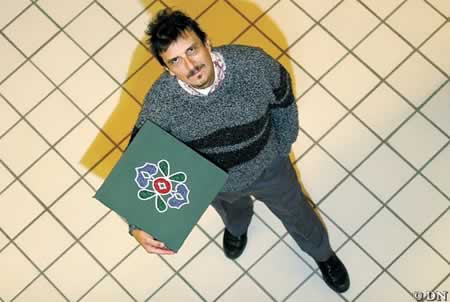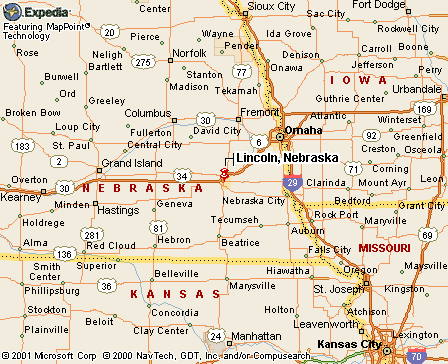|
|
Canku Ota |
|
|
(Many Paths) |
||
|
An Online Newsletter Celebrating Native America |
||
|
December 13, 2003 - Issue 102 |
||
|
|
||
|
Omaha language classes keep culture alive |
||
|
by KRYSTAL OVERMYER - Daily
Nebraskan Staff Writer
|
||
|
credits: UNL
anthropology professor Mark Awakuni-Swetland stands with an abstract
floral beadwork stylistic of the Omaha American Indian tribe. Awakuni-Swetland's
classes are hands-on and often involve field trips to the Omaha
reservation in Thurston County. photo by KRIS KOLDEN - Daily Nebraskan
|
|
To demonstrate, he forms an L-shape with his elbow, and his fingers straighten toward the ceiling. On one side of the hand, he says, you have the palm. On the other, there's the knuckled top. The two sides are different, he says, but nonetheless connected. "How can you separate the two?" he said. "They're tied together in a way you cannot separate." Like the language he teaches, Awakuni-Swetland, lecturer of anthropology and Native American studies at the University of Nebraska-Lincoln, is bound to his students and they to the culture, community and future of the Omaha Tribe of Nebraska. His Omaha classes are meant to revive the culture of the tribe through language, an oral tradition slowly becoming silent as its native speakers pass away. "The belief for many is that the loss of language is a loss of culture -- a unique identity," he said. But teaching a language that is disappearing among its speakers is difficult. These days, the first language American Indian children learn on the Omaha reservation is English. "How
do you revive a language," he said, "when even the parents
don't speak it?" Among the Omaha people, Awakuni-Swetland and his crew of students are a bit of an anomaly. Awakuni-Swetland is the white man in the tribe -- once a white boy merely interested in American Indian things, now a white professor teaching a Native American language. His students -- some American Indian, some white -- are outsiders, their presence sometimes considered an intrusion on tradition. The Omaha people can trace their ancestry in Nebraska back to the 1700s, the longest of any tribe in Nebraska. They are proud of their traditions, and it takes time for some to accept that white, college-aged students are learning and sometimes teaching their language, said Jessica Waite, a junior anthropology major. "Like everything, it's always nerve-racking the first time you go," she said, speaking of the class's visits to the Indian Culture Center in Lincoln. "You're pretty much the only white person there." Waite, whose ancestors were part of the Ogallala and Sioux tribes, said she was looking for a connection to the American Indian community when she signed up for the Omaha classes. She knew she and the other students were not just fulfilling a language requirement, but keeping the language alive for the tribe. "Most classes are consumptive," Awakuni-Swetland said. "You go in and consume a lecture or notes, regurgitating something as a paper. "In this case, your job is to learn the language while producing materials that will last beyond you." His first cohort of students to complete the program created an Omaha-English language cookbook. Waite's class, set to finish its four-semester cycle of classes this spring, will publish a how-to manual on constructing teepees. "If you know English, you can learn how to read and speak Omaha just from this book," Awakuni-Swetland said. The pinnacle of the classes' work, Waite said, came in April when the group organized a traditional "hand game" for the Indian Culture Center. When the students spoke in Omaha, it was one of the first times Waite said she felt accepted. "After they heard us speaking their language, it really felt like they were coming around to accepting us and realizing how important this course was at UNL," she said. The students realize, she said, they are among the few carriers of the Omaha language. "When
we first started, Mark told us there were probably about 40 fluent
speakers left," she said. "It kind of feels good that
we're working to keep this language alive." True to the Omaha tradition, Awakuni-Swetland is awash with relatives. He has no Native American ancestors, save those who came through his adoption. In high school in the 1970s, he took Omaha classes from a woman who later would become his adopted grandmother. After that, her relatives became his -- including an 87-year-old brother and a daughter older than he. "Even though they're all technically fictive, they are relationships that came through my adoption," he said. "And through that, I have relationships with all of their relatives." The Omaha people don't use blood to distinguish relationships, he said. The relationship determines the term -- whether a close friend or mentor becomes a sister or uncle or brother. Alberta Canby, a 73-year-old Native speaker who assists in the classroom, calls Awakuni-Swetland her nephew; he calls her his aunt. "When he calls me Auntie, it makes me feel like he's one of my children," she said. The students in the class, she said, have become like her Omaha children, too. Some students speak, she said, as if they'd known the language before. And tribal council members were amazed, Awakuni-Swetland said, at the students' April celebration. On campus, the students are the ambassadors of the Omaha people. "It's something that makes the Omaha seem like real people, not just artifacts in a museum," he said. For now, though, Waite is simply grateful for the family the class has given her. The classes are purposefully small, with about 15 students each cycle. Because the class moves in a two-year cycle, the students take class together for four semesters. The next group of students will begin the program in fall 2004. After three semesters, the group is tightly knit, Waite said. They barbecue at Awakuni-Swetland's home; they go to their elders, the speakers in their classes, for advice. She has found the language cannot be separated from the Omaha culture and the relationships it has provided. "These people may not be my blood relatives," she said, "but they are my family." |
|
|
www.expedia.com |
|
|
||
|
|
||
| Canku Ota is a free Newsletter celebrating Native America, its traditions and accomplishments . We do not provide subscriber or visitor names to anyone. Some articles presented in Canku Ota may contain copyright material. We have received appropriate permissions for republishing any articles. Material appearing here is distributed without profit or monetary gain to those who have expressed an interest. This is in accordance with Title 17 U.S.C. Section 107. | ||
|
Canku Ota is a copyright © 2000, 2001, 2002, 2003 of Vicki Lockard and Paul Barry. |
||
 |
 |
|
|
The "Canku Ota - A Newsletter Celebrating Native America" web site and its design is the |
||
|
Copyright © 1999, 2000, 2001, 2002, 2003 of Paul C. Barry. |
||
|
All Rights Reserved. |
||
 In
an office cluttered with American Indian texts and memorabilia,
Mark Awakuni-Swetland explains the marriage of his adopted language
and culture through a message in his hand.
In
an office cluttered with American Indian texts and memorabilia,
Mark Awakuni-Swetland explains the marriage of his adopted language
and culture through a message in his hand. 